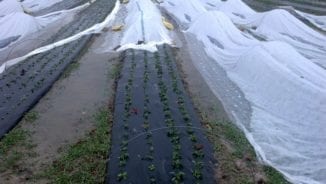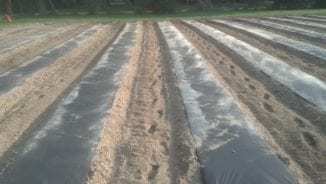Lisa Mason Ziegler
 TheGardenersWorkshop.com
TheGardenersWorkshop.com
1-757-877-7159
Farming & Business Online Courses
Field & Garden Podcast & Blog
Connect Facebook, Instagram & YouTube!
Get Farm News
Watch Lisa’s Story
I have never been sorry I made a raised bed. And on the other hand, I have been very sorry for not making them. This last week of cold rain has confirmed again I am glad I did it.
A few benefits of raised beds;

The garden above after days of wind and rain and cold temperatures. Water hangs around longer in winter for the lack of heat.
In early spring many years ago when I was a newbie to gardening, I thought; raised beds cannot make that much difference, right? So I forged ahead and planted flat beds. I learned in late May of that year with an abundance of spring showers why I should have spent a couple days shoveling my way to raised beds. The constant spring rains never allowed my plants to come up for air or to dry out a bit before the next soaking. Some plants will tolerate these conditions but few will thrive under them.
There are several ways to make a raised bed. We of course use a tractor nowadays to make the 140 beds, 100 feet long here on the farm, but I will tell you hand making beds is a far better bed and better for the garden soil structure and creatures. Another note is we soil test every garden on our farm (7) every fall to see what organic nutrients may be needed in addition to organic general purpose fertilizer. Skipping a soil testing is like gardening in the dark—come into the light and soil test annually! We like Waypoint Analytical for soil testing; they offer organic solutions for soil issues.
Depending on the situation you want to raise, here are a few tips to get a bed going;

Photo above of newly made garden beds with tractor and special implement. The surface was flat and tractor gathered the soil from pathways, formed a bed, and laid bio-degradable film all in on pass. We did this by hand for years.
Following this regiment will lead to a self-sustaining garden in just a couple of years. You will water less, your plants will grow more robustly, and pests and disease issues from an unhealthy environment will become non-existing!
Garden on!
Lisa Z
Lisa Mason Ziegler
 TheGardenersWorkshop.com
TheGardenersWorkshop.com
1-757-877-7159
Farming & Business Online Courses
Field & Garden Podcast & Blog
Connect Facebook, Instagram & YouTube!
Get Farm News
Watch Lisa’s Story